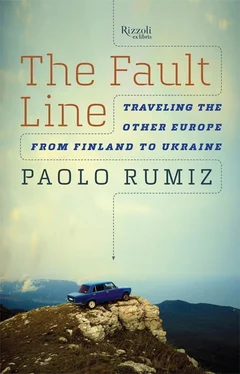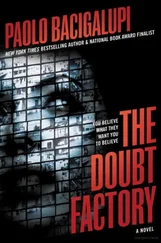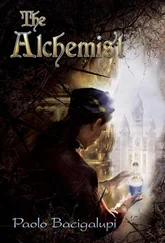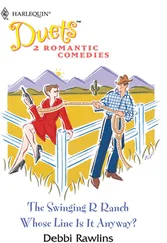The reading is eighty-one miles per hour instead of fifty. That adds up to two hundred krooni. I tell them that’s fine, but they want to know why I was going so fast. I tell them I don’t know, I was distracted, I didn’t see the sign. But they have to fill out a questionnaire thick with diaereses and double vowels, and the numbered boxes on the questionnaire do not contemplate the concept of distraction. So after some hesitation, they repeat the question, and I repeat, even more convinced, my response, so abysmally removed from their culture. I think how frustrating it must be for a Russian who lives in Estonia to have to deal with these mental pigeonholes on a daily basis. I sign the police report, receive detailed instructions on how to pay the fine, then get on my way, saying, “You are very fine people,” which leaves both of them totally disoriented.
As the road skirts the Russian border, it becomes more complicated, zigzags between glacier-formed hills full of storks, little rivers, and prehistoric menhirs called markalne in the middle of the bushes. Then, on the only straightaway of this frontier labyrinth, a ghostlike kiosk appears, its door banging in the wind, streetlamps out, and what used to be a police guard box now become a shelter for the homeless. Is this the border crossing into Latvia? Yes, it is. The only surviving sign of sovereignty are the national flags alongside the star-spangled banner of the EU. There is no longer a bar between Estonia and Latvia, and so, too—they tell me—it will be between Latvia and Lithuania. Ephemeral frontiers: the Baltic statelets had only just inaugurated them with musical bands and solemn speeches to celebrate their triple independence from the USSR, but the Europe of the Schengen Agreement made them take them down, so today everything is as it was during the cursed times when Moscow was sovereign. The three Lilliputian states with their impossible languages (they can’t even understand one another among themselves) have been forced to cohabit without the reassuring signs of sovereignty.
Forced to cohabit, I say, because they are so different. Leaving Estonia, just a few yards into Latvia, everything changes. Already in Alūksne, the first Latvian town, the flower bed nature and Protestant neatness are over, replaced by a creative disorder that is noticeably more Southern and indisputably more Catholic. Mud, puddles, terrain invaded by vegetation, marching music of the Middle European kind, the smell of sausage wafting out of the tavern on the square, the barbershop with its door open to the street. The sound of the language changes, too. The diaereses and Finnic vowels repeated to infinity fade away while “pipes” and cedillas contort themselves over and under the consonants. The spoken language is bastardized with German and Slavic words. And the people—finally—look you in the eye when they talk to you. Here we are, tumbling southward.
The unpaved road runs through the thrashing rain along the frontier with Russia. Guard towers, barbed-wire fences, light poles with storks. No more than one car every ten minutes. Bus stops forlorn on the plain, roofless, with people waiting patiently in the rain. It’s raining, but the atmosphere is cheery. The woods are a symphony of chirps and tweets; the lines of rain look like vertical staves. The air itself is full of music. We are in one of the most musical nations on Earth, a place where the epic is taught in the form of song. No other country has as many choirs and as much production of traditional choral music. An old man from the Po Valley told me many years ago that on the plains, people sing in chorus because, unlike in the mountains, there is no echo that responds, so you need the group so you won’t have to face the song all by yourself. The trees are full of insects that are tuning their instruments. Only in Greece have I heard similar choruses, with the cicadas that strike up at the first light of morning. We are in the Green Belt that runs along the border and turns into wilderness, especially here, where nobody ever comes.
When I first came to know Riga—which I found incomparably more beautiful than Stockholm—not long after Latvia’s entry into the Union, it was about music, and not politics, that I spoke with Sandra Kalniete, the young EU commissioner in Brussels, born in a Siberian Gulag to her deported parents. This woman, whose life story is so novelesque, author of the best seller With Dance Shoes in Siberian Snows , told me that the Latvians are the Italians of the Baltic, for their temperament and their love of singing. They formed their identity from choral singing. “With song,” she says, “we resisted Russification, with song we celebrated our independence, and with song we opened our arms to Europe.”
When I answered that Europe and Italy were singing less and less, she said that was all the more reason to persist. The singing of the Latvians, she said, was not the nucleus of a national identity but a universal heritage, recognized by UNESCO. It’s something that “accompanies our lives from infancy to old age.”
In Latvia, being the director of a chorus is a big deal. For at least a century, people here have been caring for and preserving this extraordinary intangible legacy. The Riga archives conserve some two million titles, from songs to folk tales, poetry and melodies. And the Latvians number two and a half million, so that’s practically one title per person. One scholar alone, Krišjānis Barons, has classified five hundred thousand, the product of a life’s research, which he left to the country gathered in a wooden chest—a mythical object that can be seen in a museum. Ms. Kalniete tells me, “We resisted the Communist Big Brother by singing. Our identity found shelter in music, in the art of allusion, in the slanted reading of the lyrics. The problem is that this mimetic endeavor absorbed enormous amounts of energy, which could have been used more freely in creative pursuits.”
In the West, there are people who still confuse Slovenia and Slovakia. Imagine how many there are who know the correct geographic sequence of the three Baltic states. In the years of the big freeze, Latvia and her sisters disappeared from the maps, and now it is hard getting the flags back in the right place. You have to start by zooming out, explain that Estonia and Lithuania are between Saint Petersburg and Warsaw. When Ms. Kalniete was the ambassador in Paris, they were always asking her, “Where is Latvia?” and she had to say: “Think of Sweden. Now, we are on the opposite shore.” Then they’d ask her, “You speak Russian, n’est-ce pas ? And she would patiently respond that no, Russian was another thing altogether. It was really hard to explain that the Baltic states didn’t have to enter Europe but simply remain there, because they had always been a part of the West. When Russian bureaucrats used to go there on vacation, they used to say with a wink, “Let’s go to Europe.” Already in the 1970s, there was a different atmosphere here compared to Russia. The coffee ritual, pastries, cleanliness. Everything was on a more human scale.
As soon as we return to our path on the edge of the Russian border, the melancholy returns: abandonment, barbed wire, guard towers. The forests sing, but the men on the frontier are silent. The terrain is scarred by train tracks overgrown with brush, useless, dilapidated crossings, empty houses. Riga is far, far away. We’re in the world of the forgotten, populated almost exclusively by Russians. The trees give way to four six-story buildings, abandoned, with holes where the windows used to be, the facades pockmarked and eaten away as though by an army of termites. On the ground, ruins. Practically like Grozny, Chechnya, after the bombings in the nineties. A single living presence among the houses: a peasant woman in boots, obviously Russian, who is hoeing the garden and signals us to go into the shack where she keeps her tools. Her name is Vera and she immediately clarifies the mystery of the ghost town. “There used to be a Soviet ceramic factory; then independence came for Latvia and the company closed. That’s when everybody left. And they took everything with them, even the wallpaper. Only five of us stayed. They put us all in the last building down at the end. I used to live there on the third floor.”
Читать дальше












